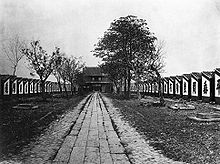Eight-part attachment
The eight-part essay ( Chinese 八股 文章 , Pinyin bā gǔ wénzhang ), a heavily ritualized and regulated essay , was one of the basic components of the official examination in the Chinese Empire under the Ming and Qing dynasties until 1902 .
The subject of these essays was the teachings of Confucius . Each of the eight sections had a fixed function (such as introduction, opening of the discussion, abstraction, etc.), and there were separate rules for each part, such as the number of sentences, format and style, as well as rhyme laws, symmetry rules and the like. Since the essay was intended to explain the meaning of a Confucian quotation by “speaking for the wise”, words, expressions, and events dating from after the Master's death (479 BC) could not be used.
The eight-part essay had no relation to reality and only served to pass the official examination. The genre is considered pedantic and trite among today's scholars.
Individual evidence
- ^ A b c Hoi K. Suen: Some very long-term and some chronic effects: The invisible dimension of the consequential basis of validity. (No longer available online.) In: 2003 International Symposium on Developing High-stakes Testing at the Korean Institute of Curriculum and Evaluation, Seoul, Korea. July 4, 2003, archived from the original on September 2, 2004 ; accessed on January 20, 2018 .
Web links
- Examination Essays: Timely and Indispensable Reading for Students in the Ming ( Memento from September 26, 2011 in the Internet Archive )
- Abolish the eight-legged essay.
